Power electronic handbook
Подождите немного. Документ загружается.

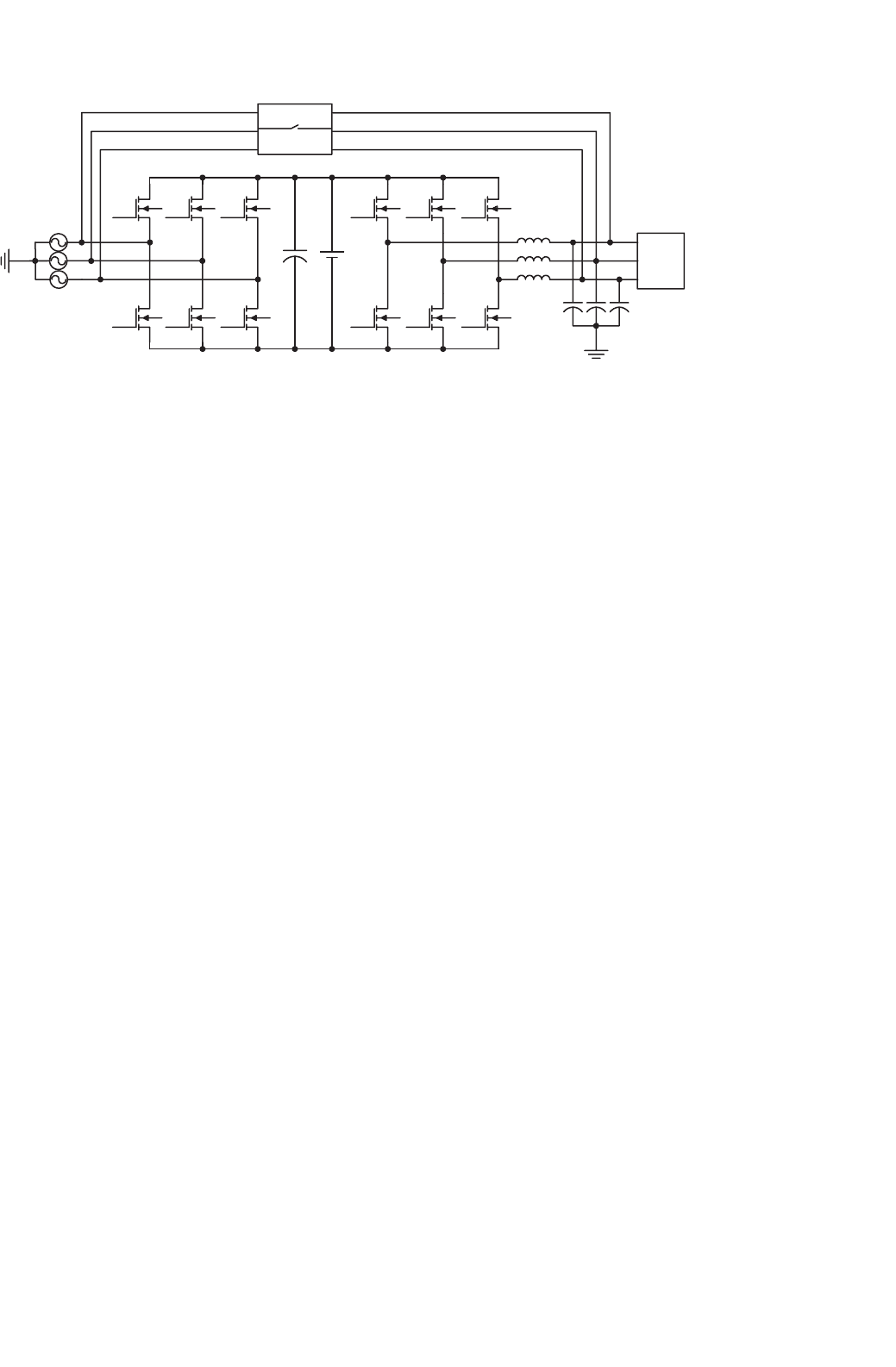
622 A. Nasiri
V
S
C
dc
S
1
S
3
S
2
S
6
Static Switch
(Normally off)
S
5
S
4
S
7
S
9
S
8
S
12
S
11
S
10
Load
L
F
C
F
FIGURE 24.6 Configuration of a three-phase on-line UPS system.
increasing the cost. When the AC input voltage is outside the
preset tolerance, the inverter and battery maintain continuity
of power to the load. The duration of this mode is the duration
of preset UPS backup time or till the AC line returns within
the preset tolerance.
The main advantages of on-line UPS are very wide tolerance
to the input voltage variation and very precise regulations of
output voltage. In addition, there is no transfer time during
the transition from normal to stored energy modes. It is also
possible to regulate or change the output frequency [8]. The
main disadvantages of this topology are low power factor, high
THD at the input, and low efficiency. The input current is
distorted by the rectifier unless an extra PFC circuit is added;
but, this adds to the cost of the UPS system [9].
As mentioned for the standby UPS system, different topolo-
gies are employed for the AC/DC rectifier and DC/AC inverter.
Unlike standby UPS system, in this system, these converters
provide power to the load continuously. Therefore, more care
should be given to the quality of the input current and out-
put voltage as well as the efficiency of the system. Figure 24.6
shows the configuration of a three-phase on-line UPS system.
The proper switching method such as PWM is employed for
the AC/DC rectifier to minimize the input current harmonics
and provide regulated DC bus voltage. A low pass filter at the
output of the system removes the switching frequency from
the output voltage.
24.2.3 Line-interactive UPS
Line-interactive UPS systems consist of a static switch, a
series inductor, a bi-directional converter, and a battery bank.
An optional passive filter can be added at the output of the
bi-directional converter or at the input side of the load. A line-
interactive UPS can operate either as an on-line UPS or as an
off-line UPS. For an off-line line-interactive UPS, the series
inductor is not required. However, most of the line-interactive
UPS systems operate on-line in order to either improve the
power factor of the load or regulate the output voltage for
the load. When the AC line is within the preset tolerance, it
feeds the load directly. The AC/DC converter is connected in
parallel with the load and charges the battery. This converter
may also be used to improve the power factor of the system
and compensate the load current harmonics. [10, 11]. Typical
configuration of a line-interactive UPS is shown in Fig. 24.7.
When a power outage occurs or input voltage falls out-
side the preset tolerance, the system goes to bypass mode.
In this mode, the bi-directional converter operates as a DC/AC
inverter and supplies power to the load from the battery set.
The static switch disconnects the AC line in order to prevent
back feed from the inverter. The main advantages of the line-
interactive UPS systems are simple design and, as a result,
high reliability and lower cost compared to the on-line UPS
systems. They also have good harmonic suppression for the
input current. Since this is a single stage conversion topology,
the efficiency is higher than on-line UPS system. The main dis-
advantage is the lack of effective isolation of the load from the
AC line. Employing a transformer in the output can eliminate
this; but, it will add to the cost, size, and weight of the UPS
system. Furthermore, the output voltage conditioning is not
good because the inverter is not connected in series with the
load. In addition, since the AC line supplies the load directly
during the normal mode of operation, there is no possibility
for regulation of the output frequency.
24.2.4 Universal UPS
This type of UPS is also called “series-parallel” or “delta con-
version.” Its topology is derived from unified power quality
conditioner (UPQC) topology and combines the advantages of
both on-line and line-interactive UPS systems [12, 13]. It can
achieve unity power factor, precise regulation of the output
voltage, and high efficiency simultaneously. Its configuration
is shown in Fig. 24.8. It consists of two bi-directional con-
verters connected to a common battery set, static switch, and
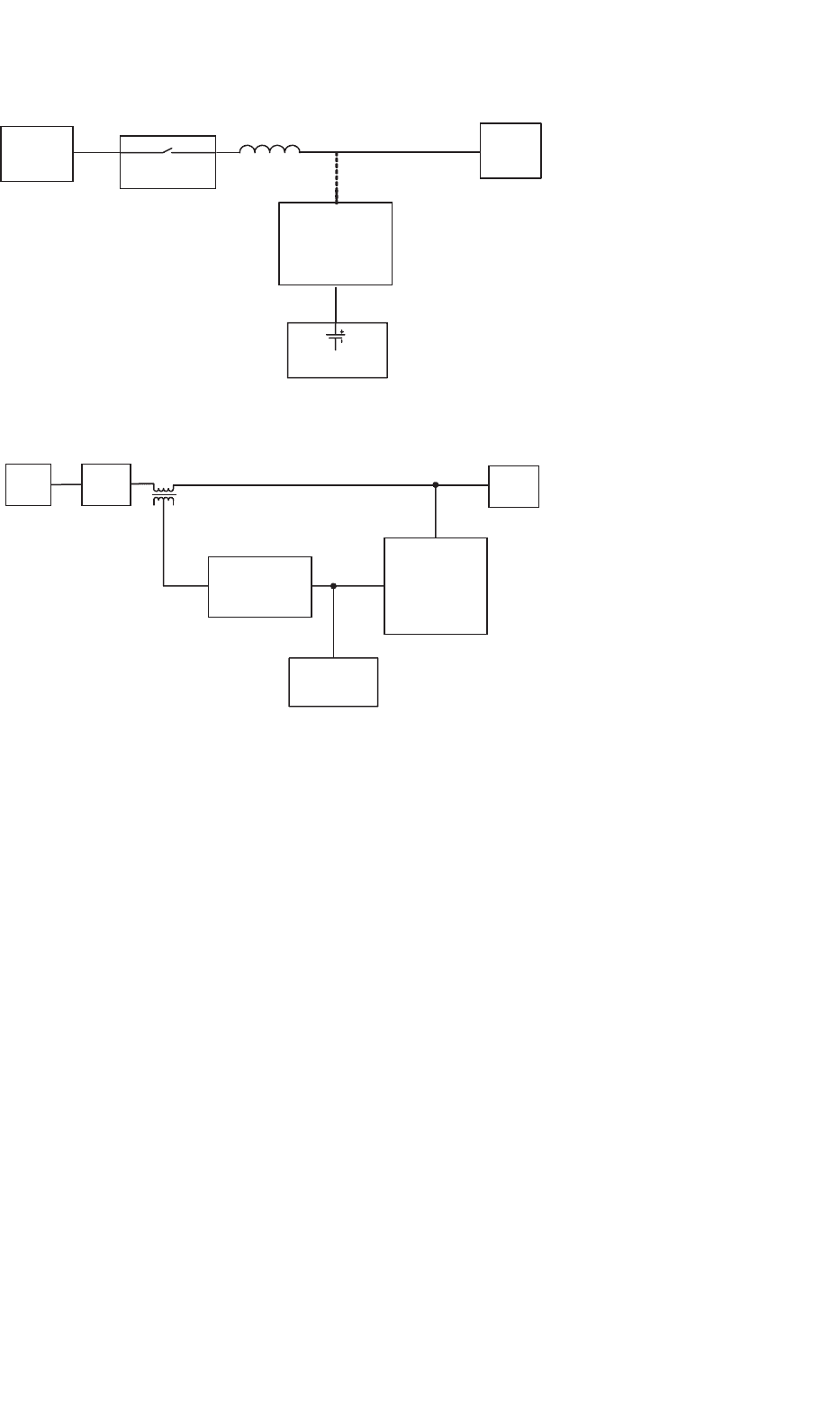
24 Uninterruptible Power Supplies 623
Static Switch
AC
Line
Load
Battery Bank
Series
Inductor
Bidirectional
AC/DC
Converter
FIGURE 24.7 A typical configuration of a line-interactive UPS system.
Series
Bi-directional
Converter
Battery Bank
Series Transformer
Static
Switch
AC
Line
Load
DC Link
Parallel
Bi-directional
converter
FIGURE 24.8 Block diagram of a universal UPS system.
a series transformer. The series bi-directional converter is rated
at about 20% of the output power of the UPS system and it
is connected via a transformer in series with the AC line. The
second bi-directional converter is the usual inverter for a line-
interactive UPS connected in parallel to the load and rated at
100% of the output power.
When the input voltage is in the acceptable range, the sys-
tem is in the bypass mode. In this mode, parallel converter
deals with current-based distortions. It mitigates load cur-
rent harmonics and improves input power factor. At the same
time, it charges the battery pack. Series converter deals with
voltage-based distortions. It cancels input voltage harmonics
and compensates voltage sags and swells. Most of the power
is supplied directly from the AC line to the load. Only a
small percentage of the input power is absorbed by parallel
converter. This power is used to compensate the differences
between input and reference voltages and to charge the bat-
tery pack. On the other hand, when the input voltage shuts
down, the static switch separates the source and the load and
the system goes to backup mode. In this situation, the par-
allel inverter acts as a DC/AC inverter and supplies power to
the load. Since a large portion of the power flows without
any conversion from the AC line to the load, the efficiency is
higher than that of an on-line UPS system. Having eliminated
the main drawback of double-conversion UPS systems, the
universal UPS topology appears to be a strong competitor of
on-line UPS systems in many applications. Figure 24.9 shows
the topology of a three-phase universal UPS system.
24.2.5 Rotary UPS
Rotary UPS systems use the stored kinetic energy in the elec-
trical machines to provide power to the load when a power
outage occurs. There are different configurations for rotary
UPS systems. The simplest topology consists of an AC motor
and an AC generator, which are mechanically coupled. A fly-
wheel is also used on the shaft of the machines to store more
kinetic energy in the system. In normal operation, the input
AC line provides power to the AC motor and this AC motor
drives the AC generator. The configuration of this system is
shown in Fig. 24.10a. In backup mode, the kinetic energy
stored in the motor, flywheel, and generator is converted
to electric power and supplies the load. This simple topol-
ogy is designed to provide short time backup power to the
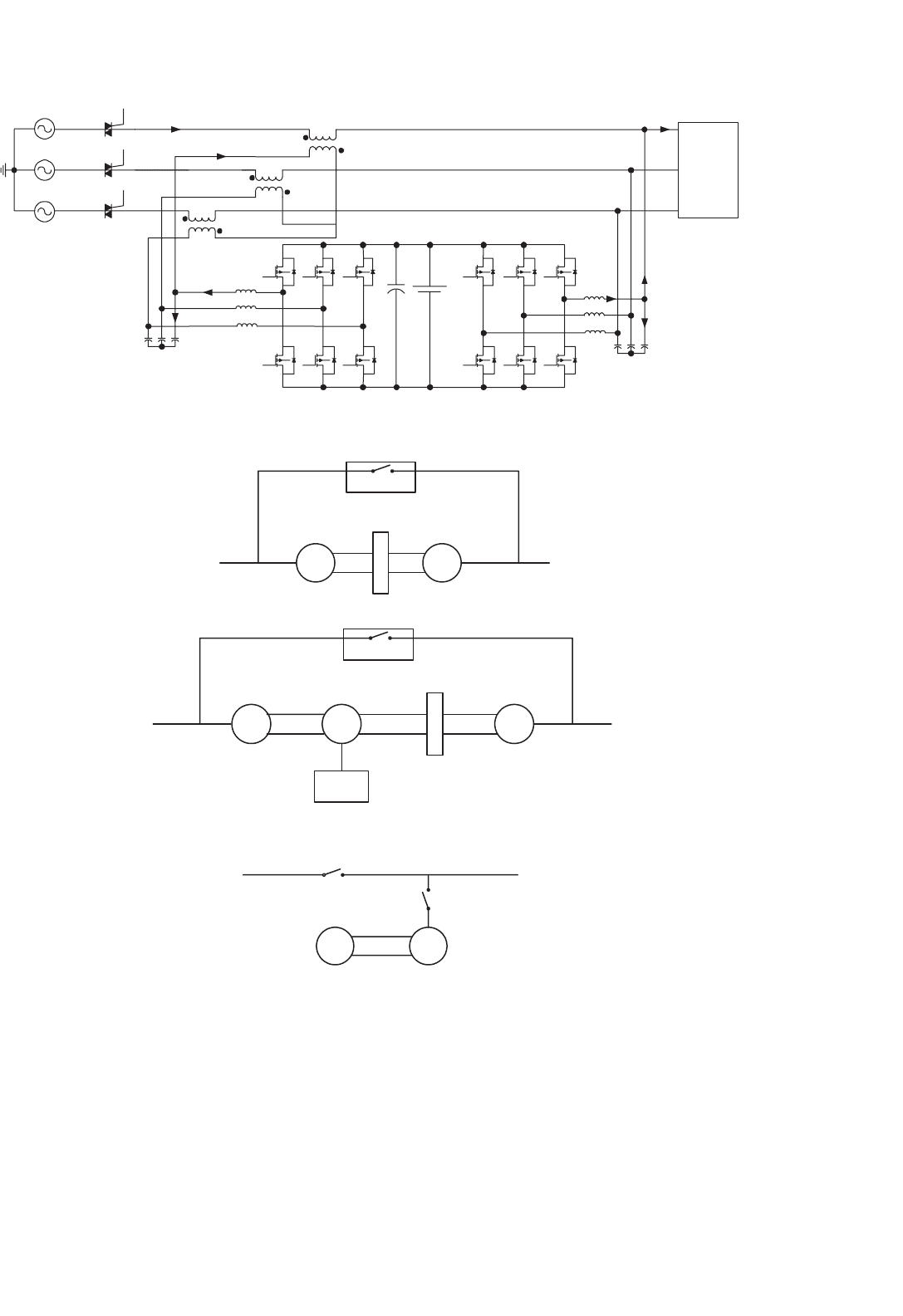
624 A. Nasiri
i
fa
Non-linear
Load
S
1
S
2
S
3
S
4
S
5
S
7
S
6
Battery
C
dc
V
fa
L
1
C
1
L
2a
V
fc
V
fb
S
8
S
9
S
10
S
12
S
11
C
2
V
sa
i
sa
i
La
i
L2a
ni
sa
V
P2a
V
P1a
V
La
i
L1a
V
fa
′
i
C2a
i
C1a
FIGURE 24.9 A universal UPS topology based on two three-leg bi-directional converters.
GM
Utility AC
Power
Utility AC
Power
Utility AC
Power
Load
AC Motor AC Generator
Flywheel
Static Switch
(a)
MG
G
Load
DC Machine AC Generator
Flywheel
M
AC Motor
Battery
Static Switch
(b)
(c)
Load
G
AC Generator
E
Diesel/ Natural
Gas Standby
Engine
Static Switch
Normally On
Static Switch
Normally Off
FIGURE 24.10 Different configuration of rotary UPS systems: (a) motor–generator set; (b) rotary UPS with battery backup; and (c) rotary UPS
with standby diesel/natural gas engine.
load (typically less than 2 s) in case of power interruption.
In another configuration of rotary UPS system which is shown
in Fig. 24.10b, an AC motor, a DC machine, an AC genera-
tor, and a battery bank are used. During the normal mode of
operation, the AC line supplies the AC motor, which drives
the DC machine. The DC machine drives the AC generator,
which supplies the load. During the backup mode of oper-
ation, the battery bank supplies the DC machine, which, in
turn, drives the AC generator and the AC generator supplies
the load. This system can provide long time backup power to
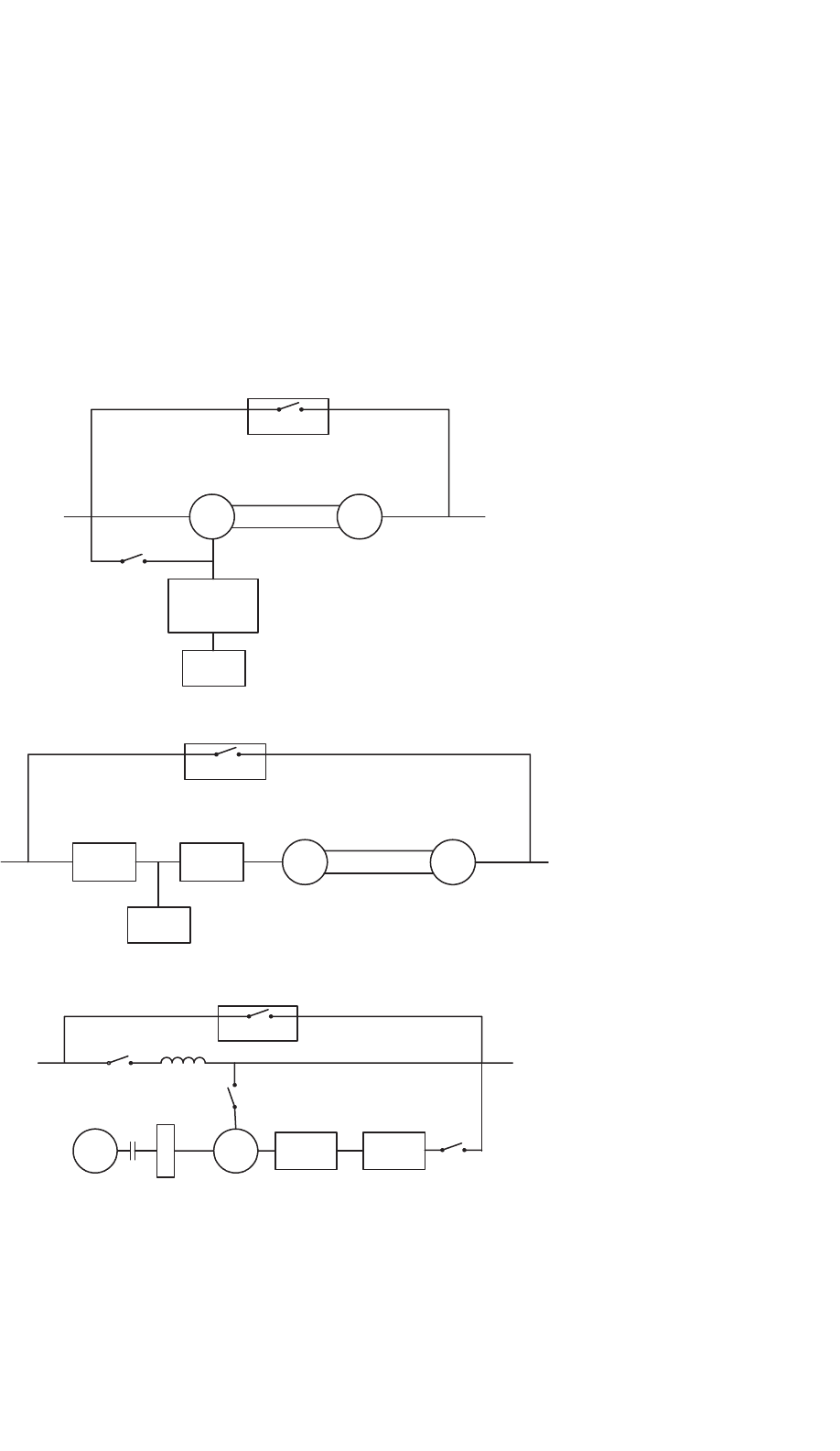
24 Uninterruptible Power Supplies 625
the load depending on the capacity of the battery set. These two
rotary UPS systems are much more reliable than the static UPS
systems and provide complete electrical isolation between the
load and input AC line. Yet, they require more maintenance
and have much bigger size and weight. Therefore, they are
usually used for high power applications [14, 15]. The config-
uration of a standby rotary UPS system is shown in Fig. 24.10c.
This system does not provide electrical isolation between the
load and input AC. There is also a transition delay for switch-
ing from main AC to backup AC generator. However, it can
provide power to the load as long as needed.
Static Switch
Static Switch
(a)
GM
Load
AC Motor AC Generator
Battery
(b)
MG
Utility AC
Power
GM
Load
AC Generator
Static Switch
Bi-directional
AC/DC
Converter
Fast Switch
AC Motor
Battery
Utility AC
Power
Utility AC
Power
Load
AC Machine
AC/DC
Rectifier
AC/DC
Rectifier
DC/AC
Inverter
DC/AC
Inverter
Diesel
Engine
Flywheel
Clutch
Series Inductor
Main Breaker
Gen. Breaker
Inverter
Breaker
(c)
FIGURE 24.11 Three configurations of hybrid rotary-static UPS systems: (a) motor–generator set with battery backup; (b) motor–generator set
with power conditioning at input side; and (c) battery-less hybrid UPS system.
24.2.6 Hybrid Static/Rotary UPS
Hybrid static/rotary UPS systems combine the main features
of both static and rotary UPS systems. They have low out-
put impedance, high reliability, excellent frequency stability,
and low maintenance requirements [6]. Typical configura-
tions of hybrid static/rotary UPS are depicted in Fig. 24.11.
They are usually used in high power applications. In the sys-
tem shown in Fig. 24.11a, during normal operation, the input
AC power feeds the AC motor. The power is provided to the
load from the AC generator, which is driven by the AC motor.

626 A. Nasiri
In case of low input power quality or power interruption, the
bidirectional AC/DC converter acts as an inverter and feeds
the AC motor from battery pack. Configuration of a hybrid
UPS system with power conditioning at the input is shown in
Fig. 24.11b. Figure 24.11c shows the configuration of a more
complicated hybrid UPS system. This system has three opera-
tion modes. In normal operation, the load is directly supplied
by the main AC input and the AC motor is rotated at no-
load. In the case of short power interruption, main breaker
and generator breaker are opened and the inverter breaker
is closed. The DC/AC inverter provides power to the load
from the kinetic energy stored in the AC machine. If power is
not restored in the short-term, the diesel engine is turned on,
which provides power to the load through the AC generator. In
this mode, the main breaker and inverter breaker remain open.
One of the advantages of this topology is operation without a
battery set to minimize cost, space, and required maintenance.
The second advantage is avoiding double power conversion in
long-term power interruption.
24.2.7 Comparison of UPS Configurations
Table 24.1 below provides the comparison between character-
istics of different types of UPS systems.
24.3 Performance Evaluation
There are four criteria for evaluating the performance of a UPS
system: quality of output voltage, input PFC and current har-
monic cancellation, transition time, and efficiency. The quality
of output voltage is the most important factor. The output
voltage of a UPS system should be sinusoidal with low THD
in different loading conditions even with non-linear loads. The
control system should have small transient responses to pro-
vide appropriate line conditioning in different loading profiles.
Typically, rotary UPS systems, which employ an AC genera-
tor at the load side, have better output voltage quality than
static UPS systems. In these systems, there is no converter
switching frequency present at the output voltage. Among the
TABLE 24.1 Performance comparison of different configurations of UPS systems
Parameter On-line Line interactive Off-line Universal Rotary Hybrid
Surge protection Excellent Good Good Good Excellent Excellent
Transition time Excellent Good Poor Good Excellent Excellent
Line conditioning Poor Good Poor Excellent Good Good
Backup duration Depends on
battery
Depends on
battery
Depends on
battery
Depends on
battery
Typically 0.1–0.5 s Depends on battery
Efficiency Low around 80% High up to 95% High High up to 95% High typically above
85%
High typically
around 95%
Input/Output
isolation
Poor Poor Poor Poor Perfect Perfect
Cost High Medium-high Low High Very high Very high
static UPS systems, on-line UPS configuration provides better
output voltage quality. In this system, output voltage is pro-
vided by a DC/AC inverter regardless of input voltage quality.
Usually, a pulse width modulation (PWM) method is used
to regulate the output voltage. This kind of UPS should be
designed to have minimum switching frequency at the out-
put and provide pure sinusoidal voltage at different loading
conditions. Followed by on-line UPS system are universal and
line-interactive configurations. In universal topology, during
normal mode of operation, the series converter provides volt-
age conditioning and regulates output voltage. In the backup
mode, the parallel converter provides the load with sinusoidal
voltage. In the line-interactive topology, during normal oper-
ation mode, input voltage directly supplies the load and no
voltage conditioning is provided. In the backup mode, the
DC/AC inverter provides the load with sinusoidal voltage.
The second criterion is transition time from normal mode
of operation to stored energy mode. On-line rotary and static
UPS systems have superior performance in this regard. The
output voltage is always provided by the output generator
or output DC/AC inverter and there is no transition time
between operation modes of the systems. However, some of
the rotary and hybrid configurations shown in Figs. 24.10 and
24.11 can only provide power to the load for a limited time.
This time is determined by the amount of kinetic energy stored
in the mechanical system. The transfer time in universal and
line-interactive topologies depends on the time necessary for
converting the power flow from the battery bank through the
inverter to the load. Improved performance is achieved by
choosing the DC bus capacitor voltage at the battery side to be
slightly higher than the floating voltage of the batteries. There-
fore, when the AC line fails, it is not necessary to sense the
failure because the DC bus voltage will immediately fall under
the floating voltage of the batteries and the power flow will
naturally turn to the load. For off-line UPS systems, the trans-
fer time is the longest. It depends upon the speed of sensing
the failure of the AC line and starting the inverter.
The next important factor is the input power factor and
the ability of the system to provide conditioning for load
power. Universal UPS system has better performance followed
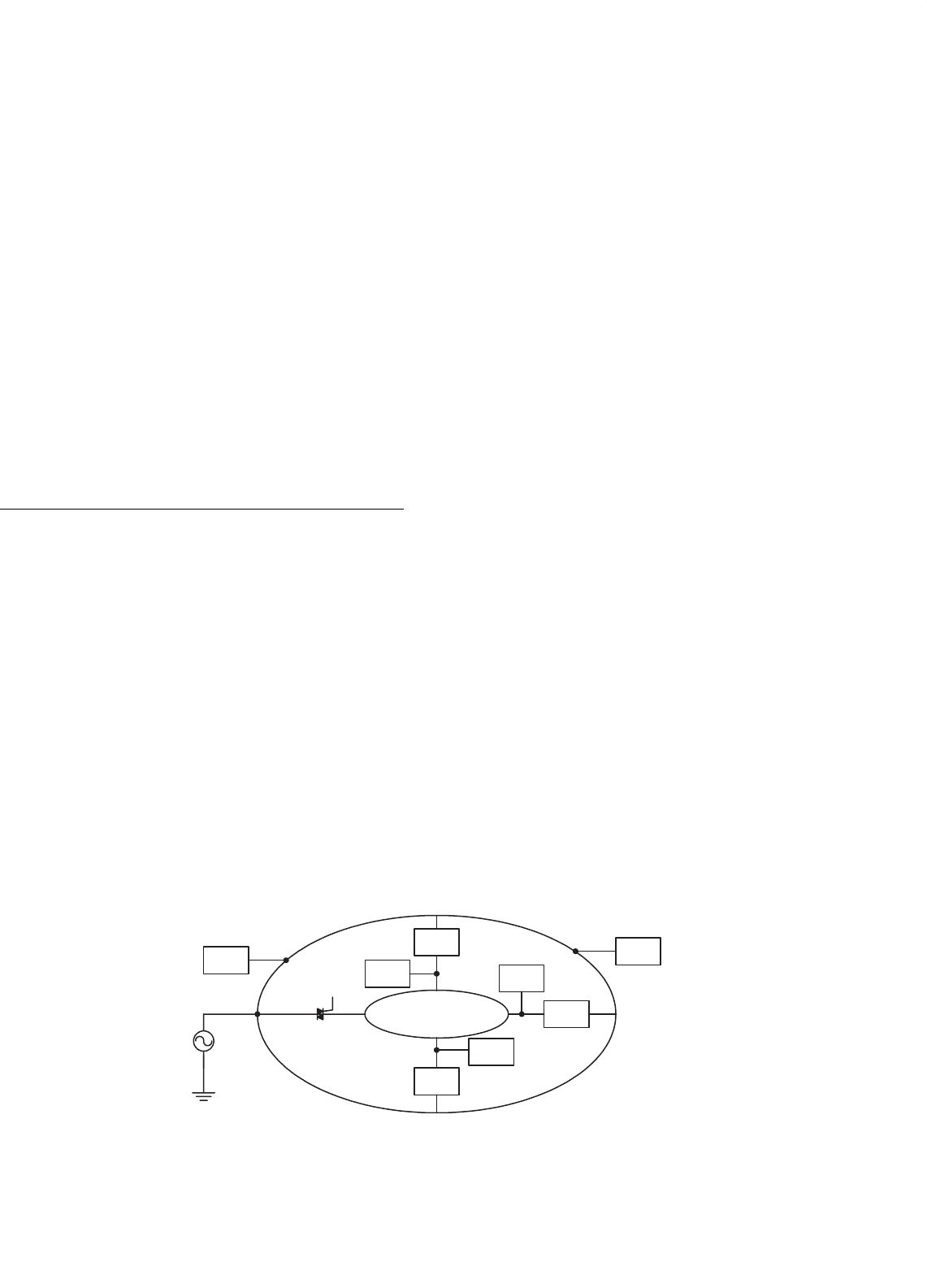
24 Uninterruptible Power Supplies 627
by line-interactive and on-line UPS in this regard. During
normal mode of operation, the parallel converter acts as an
active filter and compensates reactive current and current har-
monics generated by the load. In the line-interactive system,
the bi-directional AC/DC converter performs this task. In an
on-line UPS system, an additional system must be added to
improve PFC and mitigate current harmonics.
The last criterion for performance evaluation is efficiency.
To emphasize this factor, it should be noted that losses in UPS
systems represent about 5–12% of all the energy consumed
in data centers. Efficiency in rotary and hybrid configurations
depends on the topology of the system but typically for low
power application due to mechanical loss in the motor and
generator, the efficiency is not very high. Among the static UPS
systems, on-line UPS system has the poorest efficiency due to
double conversion. Line-interactive and universal topologies
provide higher efficiencies since most of the power directly
flows from the input AC to the load during normal operation.
24.4 Applications
The UPS systems have wide applications in a variety of indus-
tries. Their common applications range from small power
rating for personal computer systems to medium power rat-
ing for medical facilities, life supporting systems, data storage,
and emergency equipment and high power rating for telecom-
munications, industrial processing, and on-line management
systems. Different considerations should be taken into account
for these applications. For emergency systems and lighting, the
UPS should support the system for at least 90 minutes. Except
for emergency systems, the UPS is designed to provide backup
power to sensitive loads for 15–20 minutes. After this time, if
the power is not restored, the system will be gracefully shut
down. If a longer backup period is considered, a larger battery
with higher cost and space is required. For process equipment
and high power applications, some UPS systems are designed
to provide enough time for the secondary power sources such
as diesel generators to start up.
Sensitive Loads
Network
Main Power
Distribution System
Utility Power
UPS
UPS
UPS
Static Bypass
Switch
Load
Load
Load
Load
Load
FIGURE 24.12 Typical configuration of a distributed UPS network.
For industrial applications, it should be noted that UPS sys-
tems add to the complexity of the electrical system. They also
add installation and ongoing maintenance costs. They may
also add non-linearity to the system, decrease the efficiency,
and deteriorate the input PFC mechanism. The power rating
of the UPS should be appropriately selected considering the
existing load and future extensions. For many applications,
input voltage surges and spikes cause more damage than power
outages. For these systems, another device instead of UPS can
be utilized. Load characteristics should also be considered in
UPS selection. For motor loads, the inrush current, which is
sometimes 2.5 times of the rated current, should be consid-
ered. A good UPS for the motor loads is the one with higher
transient overloads. For non-linear loads such as switching
power supplies, the input current is not sinusoidal. There-
fore, the instantaneous current is higher than the RMS current.
This high instantaneous current should be considered in UPS
selection.
For a power distribution network, two different approaches
are taken to support sensitive loads. In a distributed approach,
which is more suitable for highly proliferated loads such as
medical equipment, data processing, and telecommunications
many separate UPS units operate in parallel to supply critical
loads. UPS units are placed flexibly in the system to form a
critical load network. A typical on-line distributed UPS sys-
tem is shown in Fig. 24.12. High flexibility and redundancy
are the main advantages of distributed systems. Individual load
increase can be supported by adding more UPS systems. Con-
sideration for future extension can also be delayed until the
loads are added. On the other side, this method has some dis-
advantages. The load sharing between different UPS units is a
difficult task. Complicated digital control methods and com-
munication between units are required to perform optimal
load sharing. The second disadvantage is that the monitoring
of the whole system is difficult and requires specially trained
staff.
The other method to support distributed loads is to use a
large UPS unit to supply all the critical loads in a centralized
approach. This approach is more desirable for industrial and
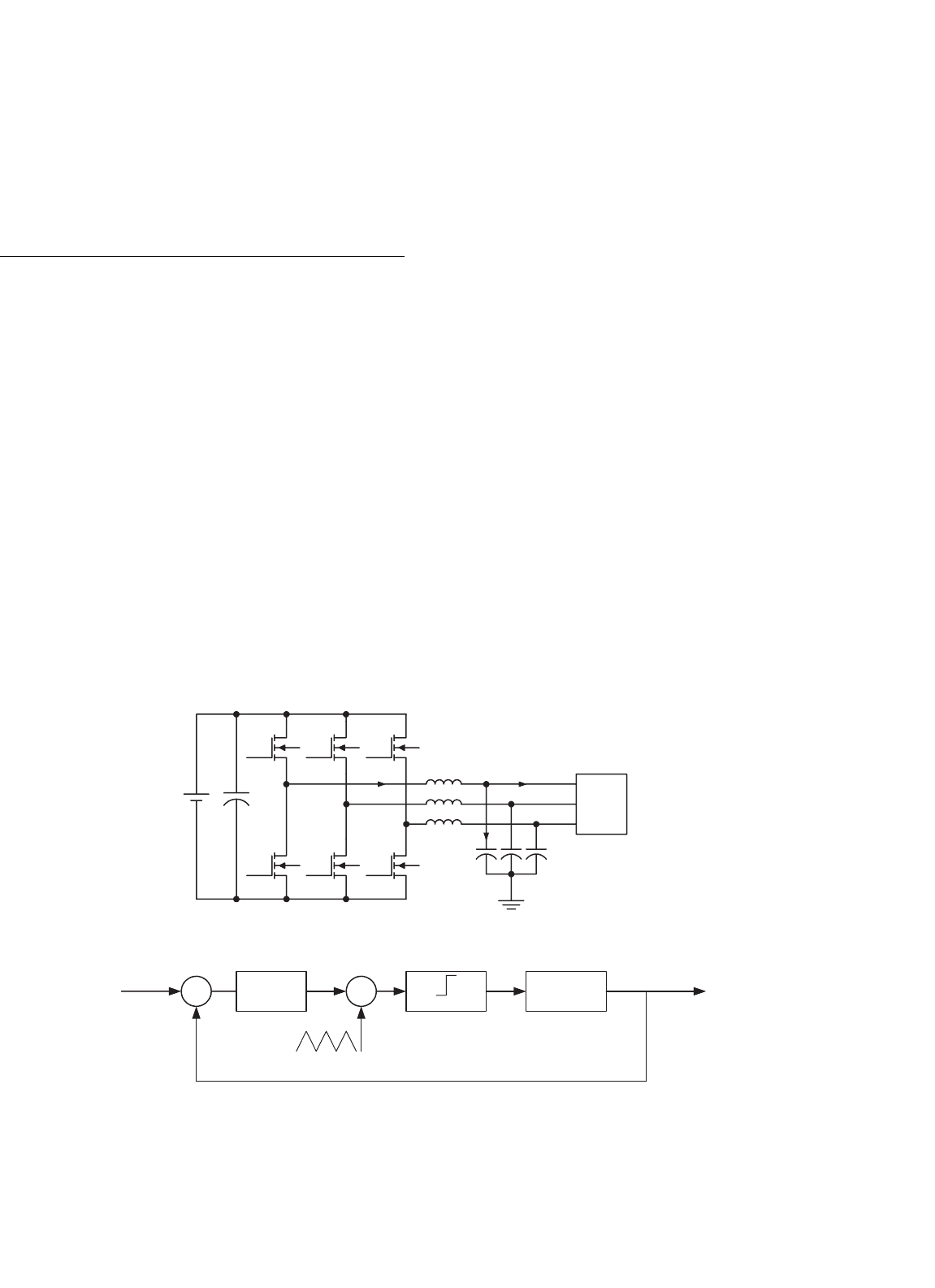
628 A. Nasiri
utility applications. The advantage of this method is easier
maintenance and troubleshooting. The disadvantages on the
other side are lack of redundancy and high installation cost. In
addition, consideration for system expansion should be taken
into account when the original UPS unit is selected.
24.5 Control Techniques
The main task of the control system in a UPS unit is to
minimize the output voltage total harmonic distortion in dif-
ferent loading profiles. In addition, it should provide the
proper mechanism to recharge the battery set and maintain
high input power factor and low total input current har-
monic distortion. Other factors considered for a good control
technique are nearly zero steady-state inverter output volt-
age error, good voltage regulation, robustness, fast transient
response, and protection of the inverter against overload under
linear/non-linear loads.
The most common switching technique is Sinusoidal PWM.
This method can be utilized for both single-phase and three-
phase systems. The advantage of this method is low output
voltage harmonic and robustness. This strategy uses a single
feedback loop to provide well-regulated output voltage with
low THD. The feedback control can be continuous or discon-
tinuous. Analog techniques are used in continuous approach.
The sinusoidal PWM (SPWM) can be of natural sampling type,
average type, or instantaneous type [17, 18].
Load
S
1
S
3
S
4
S
2
S
5
S
6
L
F
C
F
V
a
V
b
V
c
V
dc
V
A
V
B
V
C
i
LF
i
La
i
Ca
(a)
+
_
V
a
*
V
a
PID
Controller
+
_
V
Control
V
Triangle
Comparator
Gate of
S
1
and S
2
V
a
(b)
FIGURE 24.13 (a) Configuration of a three-phase DC/AC inverter for UPS systems and (b) simple voltage controller using PWM technique.
In natural sampling type, the peak value of the output volt-
age is detected and compared with a reference voltage in order
to obtain the error, which is used to control the reference to
the modulator. The average approach is basically the same; but,
the sensed voltage is converted to an average value and after
that, is compared with a reference signal. These approaches
control only the amplitude of the output voltage and are good
only at high frequencies. In an instantaneous voltage feedback
SPWM control, the output voltage is continuously compared
with the reference signal improving the dynamic performance
of the UPS inverter.
A typical block diagram of a three-phase DC/AC inverter
for UPS systems and SPWM switching control technique is
shown in Fig. 24.13. The disadvantage of this method is lack
of flexibility for non-linear loads. Other programmed PWM
techniques such as selective harmonic elimination, minimum
THD, minimum loss, minimum current ripple, and reduced
acoustic noise may be used for the inverter.
Better performance even with non-linear and step-changing
loads can be achieved by multiple control loop strategies [19].
As shown in Fig. 24.14, there are two control loops: an outer
and an inner. The outer control loop uses the output voltage
as a feedback signal, which is compared with a reference sig-
nal. The error is compensated by a PI-integrator to achieve
stable output voltage under steady-state operation. This error
is also used as a reference signal for the inner current regula-
tor loop, which uses the inductor or the capacitor output filter
current as the feedback signal. The minor current loop ensures
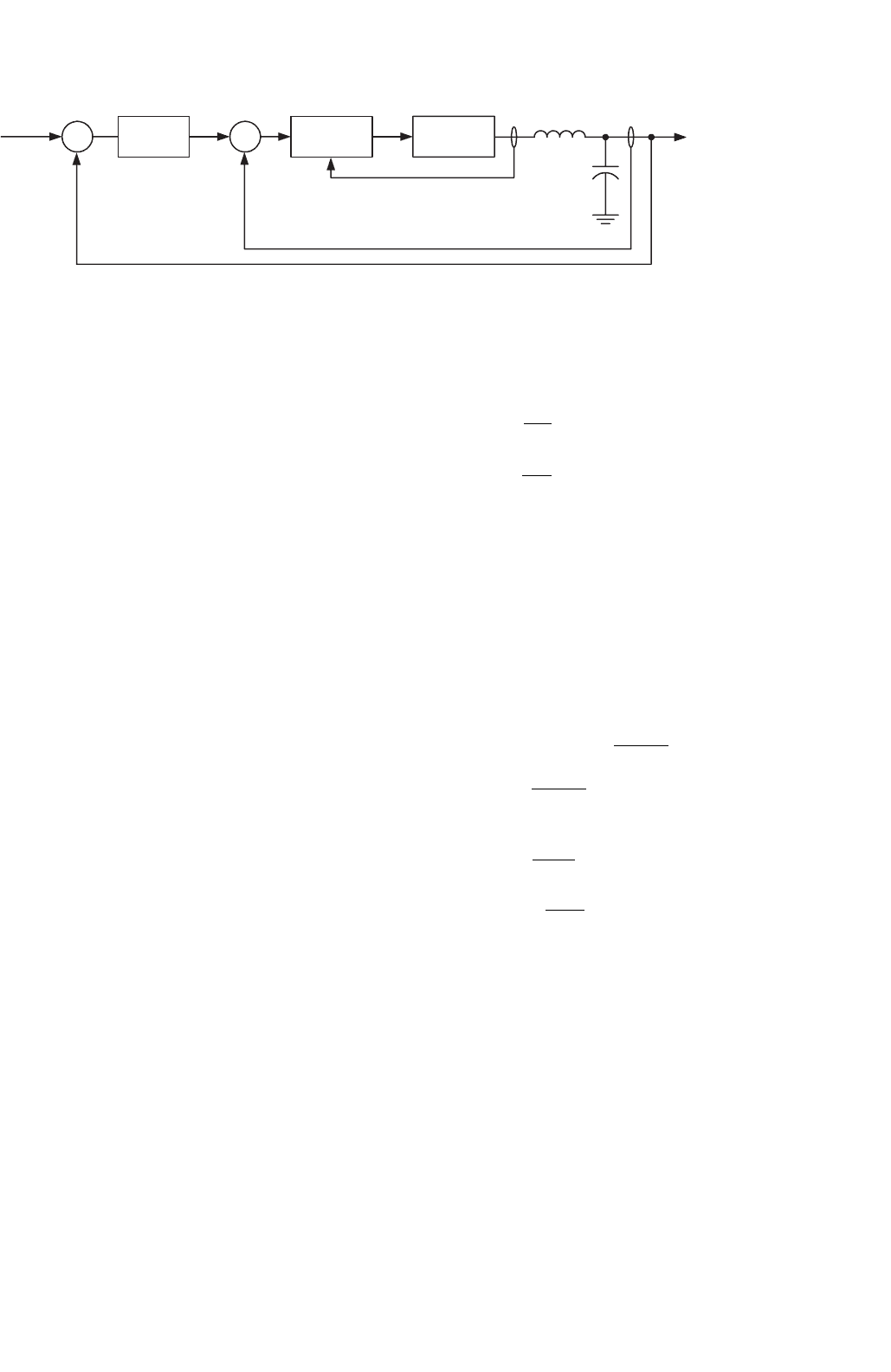
24 Uninterruptible Power Supplies 629
V
a
*
+
_
V
a
PID
Controller
+
_
Current
Regulator
Gate of
S
1
and S
2
V
a
L
F
C
F
i
La
i
LF
i
LF
*
FIGURE 24.14 Typical current and voltage control loops for UPS inverter.
fast dynamic responses enabling good performance with non-
linear or step-changing loads. The basic current regulators
employed as minor current loop are: hysteresis regulators,
sinusoidal PWM regulator, and predictive regulators. In a typ-
ical hysteresis regulator, the reference signal is compared with
the feedback signal. The sign and predetermined amplitude of
the error determine the output of the modulator. The dura-
tion between two successive levels is determined by the slope
of the reference signal. The output voltage tracks the reference
signal within the upper and lower boundary levels. This hys-
teresis control has fast transient response; but, the switching
frequency varies widely [20].
In SPWM control technique, the output voltage feedback
is compared with a sine reference signal and the error volt-
age is compensated by a PI-regulator to produce the current
reference. The current through the inductor or the capaci-
tor is sensed and compared with the reference signal. After
being compensated by a PI-regulator, the error signal is com-
pared with a triangular waveform to generate SPWM signal for
switching control. The SPWM current control has a constant
switching frequency and also provides fast dynamic responses.
In predictive current control method, the switching instants
are determined by suitable error boundaries. When the current
vector touches the boundary line, the next switching state vec-
tor is determined by prediction and optimization in order to
minimize the error. Predictive current control requires a good
knowledge of the load parameters. All these current regulators
are typically used as an inner loop to regulate the current in
the filter inductor. The current reference for the current reg-
ulator is obtained by summing together the error in an outer
voltage loop with the actual load current to yield the rated
output voltage.
With the increase of speed and reliability of digital proces-
sors and a decrease in their cost, digital processors have been
facing an enormous growth of popularity in control applica-
tions in the past few years. Many digital and discrete control
techniques such as dead-beat control [21], dissipativity-based
control [22], sliding-mode control [23], space vector-based
control [24], and multiple-feedback loop [25] have been
developed using digital signal processors (DSP).
In this section, fundamental analysis of a dead-beat control
method is explained for the three-phase UPS configuration
shown in Fig. 24.13a. The state space equations of one phase
of this system in the continuous time-domain are as follows.
C
F
dV
a
dt
= i
LF
−i
La
(24.1)
L
F
di
LF
dt
= V
A
−V
a
(24.2)
Considering V
a
and i
LF
as state variables, the state space
equation of the system is as follows:
V
a
i
LF
•
=
01/C
F
−1/L
F
0
V
a
i
LF
+
0
1/L
F
V
A
+
−1/C
F
0
i
La
(24.3)
These continuous time-domain state space equations are con-
verted to the discontinuous time domain with a sampling
period of T
s
[26].
V
a
(k + 1)
i
LF
(k + 1)
=
cos ω
0
T
s
sinω
0
T
s
ω
0
C
F
−
sinω
0
T
s
ω
0
L
F
cos ω
0
T
s
V
a
(k)
i
LF
(k)
+
1 −cos ω
0
T
s
1
ω
02
L
F
sin ω
0
T
s
V
A
(k)
+
−
1
ω
0
C
F
sin ω
0
T
s
1 −cos ω
0
T
s
i
La
(k)
(24.4)
Where ω
0
is the angular resonance frequency of L
F
and C
F
.
The sampling frequency of the system is always considered
much higher than the resonance frequency of L
F
and C
F
. With
this assumption, Eq. (24.4) is simplified to Eq. (24.5). This
conversion is valid for almost f
s
≥ 20f
0
.
V
a
(k +1)
i
LF
(k +1)
=
1 T
s
/C
F
−T
s
/L
F
1
V
a
(k)
i
LF
(k)
+
0
T
s
/L
F
V
A
(k)+
−T
s
/C
F
0
i
La
(k) (24.5)
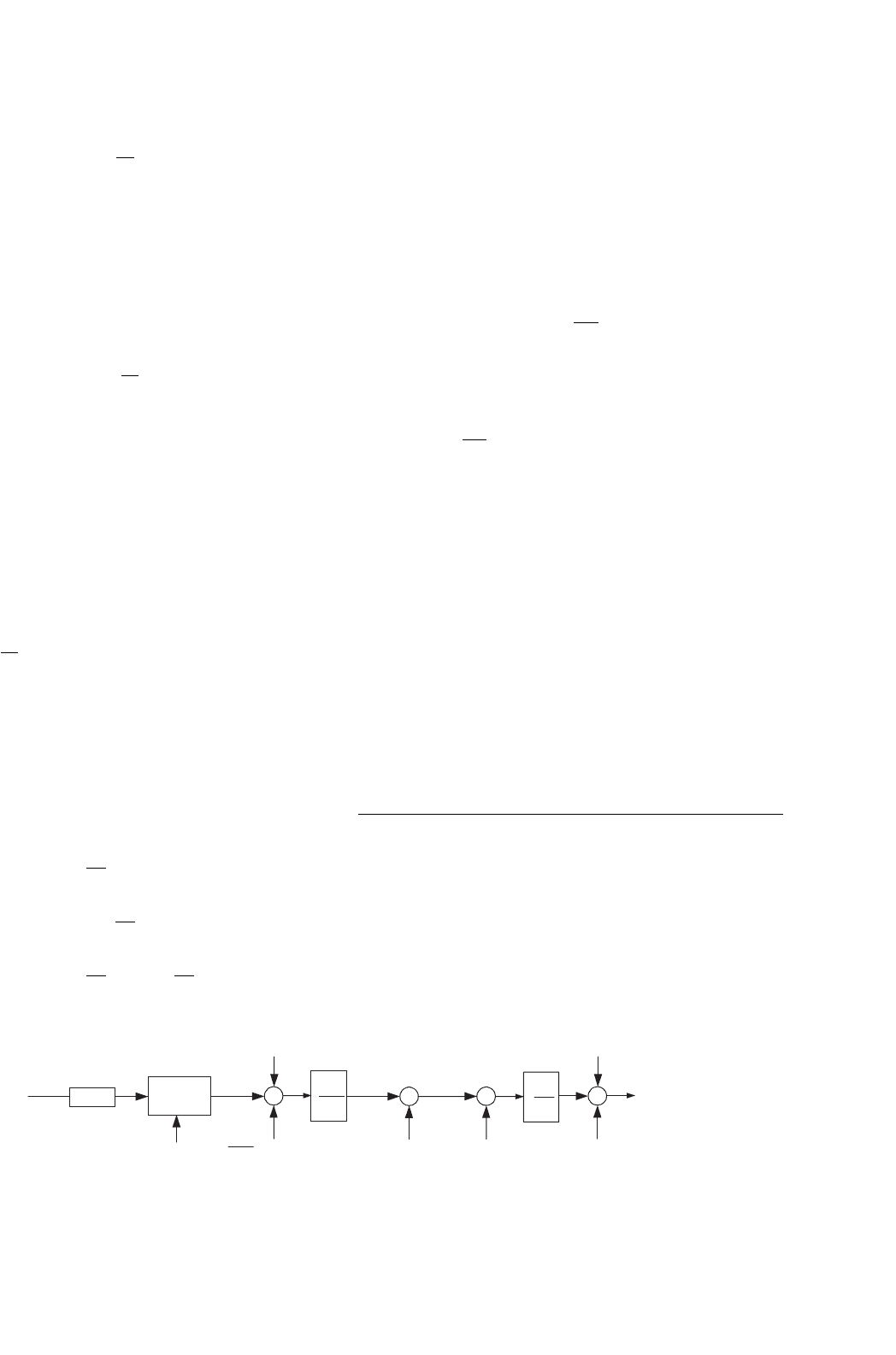
630 A. Nasiri
The current equation according to Eq. (24.5) is given by:
i
LF
(k + 1) = i
LF
(k) +
T
s
L
F
[V
A
(k) − V
a
(k)] (24.6)
Alternatively, this equation can be achieved by converting
Eq. (24.2) from a differential equation to a difference equa-
tion. The same suggestion of f
s
≥ 20f
0
has to be made for this
conversion as well. If V
a
and i
∗
LF
are considered constant over
the next switching period, the output voltage of the inverter,
which corrects the error of i
LF
after two sampling periods, is
described by:
V
A
(k + 1) = V
a
(k + 1) +
L
F
T
s
[i
∗
LF
(k + 1) − i
LF
(k + 1)]
(24.7)
A linear estimation of V
a
(k +1) can be achieved from previous
values:
V
a
(k +1)=V
a
(k)+[V
a
(k)−V
a
(k −1)]=2V
a
(k)−V
a
(k −1)
(24.8)
By substituting Eqs. (24.8) and (24.10) in Eq. (24.9) and updat-
ing reference current for i
LF
in every two sampling periods, the
dead-beat digital control for series converter is described by:
V
A
(k +1)=
L
F
T
s
[i
∗
LF
(k)−i
LF
(k)]−V
A
(k)+3V
a
(k)−V
a
(k −1)
(24.9)
Equation (24.9) ensures that the current error between i
LF
and
i
∗
LF
at time k +2 goes to zero with a delay of two sampling peri-
ods. Avoiding interaction between voltage and current control
loops, load voltage, V
a
, is sampled at half of the current sam-
pling frequency. The voltage equation according to Eq. (24.5)
is as follows.
V
a
(k + 1) = V
a
(k) +
T
s
C
F
i
CF
(k) (24.10)
V
a
(k + 2) = V
a
(k + 1) +
T
s
C
F
i
CF
(k + 1)
= V
a
(k) +
T
s
C
F
i
CF
(k) +
T
s
C
F
i
CF
(k + 1) (24.11)
V
sa
PLL
A/D
Converter
+
+
V
a
*
V
a
*
(k)
V
a
(k)
Source
Voltage
f
s
sampling
frequency
2T
S
C
F
2T
S
(k– 2)i
CF
C
F
+
–
–
V
A
(k+1
)
V
a
(k)
L
F
T
S
i
LF
(k)
i
*
LF
(k)i
*
CF
(k)
i
La
(k)
+
–
3V
a
(k) –V
a
(k–1)
+
–
–
FIGURE 24.15 Implementation of the current and voltage control for the inverter shown in Figure 24.13a.
As current control is suggested to be dead-beat with a delay of
two sampling periods, capacitor current at time k and (k+1)
are given by:
i
CF
(k) = i
∗
CF
(k − 2), i
CF
(k + 1) = i
∗
CF
(k − 1) (24.12)
Substituting Eq. (24.12) in Eq. (24.11) and updating the refer-
ence current at each of the two sampling periods, V
a
(k +2) is
given by:
V
a
(k + 2) = V
a
(k) +
2T
s
C
F
i
∗
CF
(k − 2) (24.13)
The current of i
∗
CF
at time k which corrects the voltage error
of V
a
at time k + 4 is as follows.
i
∗
CF
(k) =
C
F
2T
s
[V
∗
a
(k) − V
a
(k)]−i
∗
CF
(k − 2) (24.14)
A block diagram of the implementation of voltage and current
control of the inverter is shown in Fig. 24.15. Block diagram
of the current and voltage controller for the inverter is also
shown in Fig. 24.16. Voltage regulator is a pure dead-beat
controller with a delay of two sampling periods including the
consumed time for calculation. G
1
is the time delay needed
for calculations and analog to digital conversions. G
2
is the
time delay caused by the PWM inverter and G
3
is the transfer
function of the low pass filter. Current regulator is also consid-
ered as a pure delay. The output voltage of the inverter follows
its reference with four sampling periods of delay. In practice,
the dynamics of the current regulator is not a pure delay and
shows some deviation from the dead-beat controller.
24.6 Energy Storage Devices
In this section, three dominant energy storage devices for the
existing and future UPS systems are described. These energy
storage devices are battery, flywheel, and fuel cell.
24.6.1 Battery
Battery is the energy storage component of current static UPS
systems. It determines the capacity and run-time of the UPS.

24 Uninterruptible Power Supplies 631
G
1
= e
–sT
S
Current
Regulator
Equation (24.9)
Current
Regulator
Equation (24.14)
s +T
d
1+L
F
C
F
s
2
11
G
3
=
G
2
=
+
+
V
a
*
(k)
i
CF
(k)
i
CF
(k)
V
a
(k)
*
FIGURE 24.16 Block diagram of the current and voltage controller for the inverter shown in Figure 24.13a.
For small units, it is the size of battery that determines the
size of the UPS. Different types of batteries are used in UPS
systems but the most commonly used types are lead-acid,
nickel–cadmium, and lithium ion. The lead acid batteries used
in this application are the same as the ones used in the cars.
However, there is one small difference. Car batteries generate
electricity by the reaction of sulfuric acid on lead plates that
are drowned under the liquid. These types of battery cells are
not suitable for UPS applications because there is a chance
of acid spillage from them. In addition, during the charging
process, they release hydrogen that is explosive and dangerous
in a closed environment. Lead acid batteries used in UPS sys-
tems are a special kind called sealed or valve-regulated. The
nickel–cadmium batteries are another popular type of batter-
ies used in UPS systems. They usually provide higher energy
and power density compared to lead-acid batteries. The nom-
inal voltage of nickel–cadmium cells is 1.2 V, which is smaller
than 1.5 V of lead-acid batteries. However, the cell voltage
variation throughout different charge levels is less than lead-
acid batteries. These batteries also have less series resistance
and can provide higher surge currents. Lithium-ion batteries
have much higher energy density. This kind of battery can be
molded into different shapes. They have a nominal voltage
of 4.2 V. The main disadvantage of lithium-ion battery is that
they lose their capacity from the time of manufacturing regard-
less of their charge level and conditions of use. Table 24.2
shows a comparison between different kinds of batteries for
UPS application.
TABLE 24.2 A comparison between different types of batteries for
UPS systems
Battery type Energy density
(WH/kg)
Power density
(W/kg)
Commercial
availability
Lead-acid 35 300 Very mature and
readily available
Nickel–cadmium 40 200 Mature and
available
Lithium-ion 120 180 Available
Nickel hydride 70 200 Available
Zinc-air 350 60–225 Research stage
Aluminum-air 400 10 Research stage
Sodium chloride 110 150 Available
Sodium sulfur 170 260 Available
Zinc bromine 70 100 Available
The traditional method of charging batteries is to apply con-
stant current and constant voltage in two consecutive periods.
Constant current is applied at the beginning of a typical full-
charge cycle, when the battery voltage is low. When the battery
voltage rises to a specified limit, the charger switches to con-
stant voltage and continues in that mode until the charging
current declines to nearly zero. At that time, the battery is
fully charged. During the constant-voltage phase, the current
drops exponentially due to the sum of battery resistance and
any resistance in series with the battery (much like charg-
ing a capacitor through a resistor). Because current drops
exponentially, a complete, full charge takes a long time.
24.6.2 Flywheel
Flywheel is simply a mechanical mass that is placed on the shaft
of a motor–generator set and stores mechanical energy in the
form of kinetic energy. When the electrical power is required,
this kinetic energy is converted to electricity by the genera-
tor coupled with the flywheel. Flywheels are the oldest type of
energy storage devices. The advantages of flywheel energy stor-
age systems are high efficiency, high energy and power density,
and long life. On the other hand, flywheels are more expen-
sive and require more space than batteries and fuel cells. There
are also some safety concerns about flywheels rotating at high
speeds.
24.6.3 Fuel Cell
Due to high efficiency and low emissions, fuel cell systems
have been gaining popularity in recent years. A fuel cell uses
hydrogen as fuel and produces electricity, heat, and water from
the reaction between hydrogen and oxygen. Each cell consists
of an electrolyte and two electrodes as anode and cathode.
Figure 24.17 shows the configuration of a typical fuel cell sys-
tem. There are different kinds of fuel cell system depending on
the types of electrolyte and hydrogen sources. Some fuel cell
systems have an on-board fuel reformer and generate hydrogen
from natural gas, methanol, and other hydrocarbons. Recent
technology development in this field has made fuel cells a more
reliable and cost-effective alternative for batteries. Fuel cells
currently have a variety of applications in automotive, electric
utility, and portable power industries. Table 24.3 provides a
comparison between the most popular types of fuel cells.
